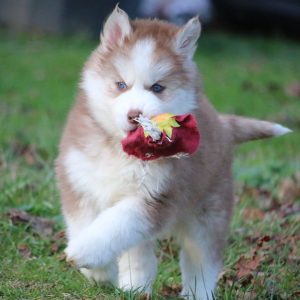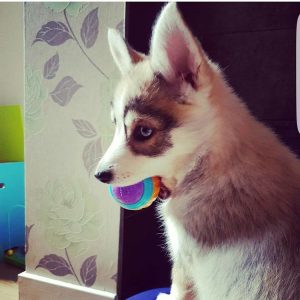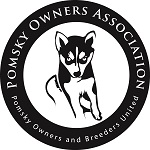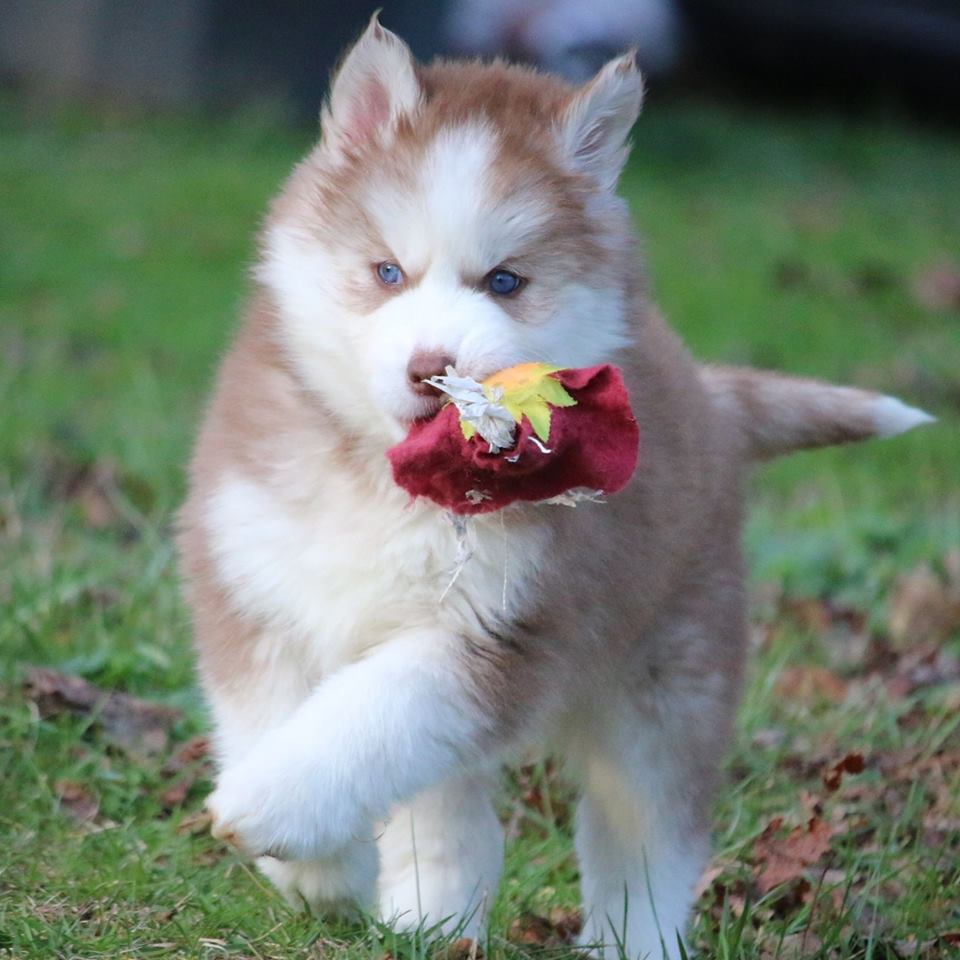How to Train a Pomsky (the method that works)
Welcome to part one of our pomsky training mini-series. In this mini-series, we’re giving you bits
and pieces from our Pomsky Training Book to help you train the perfect pomsky.
This is just part 1 of the pomsky training mini-series. You can access the other parts of our training series here:
- Part 1: How to train a Pomsky (the method that works)
- Part 2: 5 tips before you begin Pomsky training
- Part 3: The most important aspect of Pomsky training
- Part 4: The top two commands to teach your Pomsky today
- Part 5: The 3 Pomsky behaviors to correct and train
For additional pomsky training tips including step by step instructions on how to train engagement and important commands, download our pomsky training guide:
Two Pomsky Training Methods
 Training techniques vary far and wide. There’s no one size fits all training method, it truly depends on the puppy. According to Kanzaidy of SZ Pomskies “When it comes to training methods, it depends on the puppy. A shy, timid puppy isn’t going to respond well to physical discipline as its going to make them more shy and timid and become fearful. However, a more dominant puppy that ignores all efforts of non-physical discipline might need some touch contact to get them to understand what they are doing is wrong.”
Training techniques vary far and wide. There’s no one size fits all training method, it truly depends on the puppy. According to Kanzaidy of SZ Pomskies “When it comes to training methods, it depends on the puppy. A shy, timid puppy isn’t going to respond well to physical discipline as its going to make them more shy and timid and become fearful. However, a more dominant puppy that ignores all efforts of non-physical discipline might need some touch contact to get them to understand what they are doing is wrong.”
For the purpose of simplification we’ve grouped the various training methods into two broad categories:
- Positive
- Balanced
The Positive Training Method
What we’re referring to as the “positive” technique is often referred to as the “modern” method or “science based” method in the dog training industry. The positive method attempts to provide a happy outcome when the pomsky behaves correctly; a good behavior is rewarded with treats and praise while bad behavior is ignored. The intention of this method is to treat your pomsky in the most humane way possible.
The trick to the positive training method is: don’t punish bad behavior, instead reward good behavior. Jo of Moonlit Pomskys says “Ask for a behavior that is good and praise that. For a new puppy that needs to be trained, the positive technique is certainly the way to go.”
For example, when your pomsky is jumping on guests instead of pushing your pomsky down and saying “no” try asking your pomsky to sit and then reward them with a treat. Alternatively, try ignoring your pomsky jumping until they’re bored and sitting then reward them with a treat for sitting and behaving. This positive reinforcement teaches your pomsky that if they are sitting and waiting for attention they will be rewarded but if they jump and demand attention they will be ignored and will not receive a reward. You can check out this page to find professional dog trainers in your area and learn more from the experts.
 The Balanced Training Method
The Balanced Training Method
What we’re referring to as the “balanced” technique is a mixture of positive reinforcement (like we described in the positive technique) and corrective actions. Corrections are used to startle the pomsky when they are misbehaving; teaching the pomsky that something unpleasant will happen if they misbehave. It’s important to stress that this method does not, in absolutely no way, incorporate physical harm or beating of a pomsky.
The basis of this technique is finding a balance between positive and negative operant conditioning. When the pomsky behaves they are rewarded and encouraged to repeat a good behavior, teaching the pomsky what’s allowed. When the pomsky misbehaves they are corrected and discouraged from repeating a bad behavior, teaching the pomsky what’s not allowed. Reward your pomsky with praise and treats when they behave and reprimand your pomsky when they misbehave.
Which Method is Best?
Positive training should be the first training method that you try. Especially with a young pomsky, it’s easiest to train a pomsky with the positive technique before the pomsky learns bad behavior. Attempt to train your pomsky using the positive training technique before you attempt the balanced technique, the positive training technique is the superior training method and is quickly becoming the primary training technique of dog trainers around the world.
That being said, the positive training technique is not for everyone. Every pomsky is unique; the positive training technique might not work for your pomsky. You may find that your head strong pomsky has learned bad behavior and simply doesn’t respond to your positive reinforcement. Some pomsky trainers and breeders prefer the balanced technique over the positive technique. When asked, Lauren of Pristine Pomskies says “I have tried positive reinforcement training, but with this breed, they will weigh their options. If you ask them to sit they are going to look at you to see if you have a treat. If you have a treat, they may or may not listen because whatever they are doing might be more interesting. I have found the best results using negative reinforcement.”
We recommend the positive method but each pomsky is unique, your pomsky might respond better to the balanced method while others respond best to the positive method. The important thing is, you must know your pomsky, know what they respond to best to and choose a technique. Choose a technique and stick to it.
How to Train the Positive Way
Here’s an example of how to train using the positive technique.
- Step 1: Take a handful of treats and hold it in a fist. Let your pomsky sniff your hand to figure out that you are holding treats.
- Step 2: Continue holding your hand with treats closed in your fist until the pomsky realizes that sniffing and begging won’t make you open your hand. This teaches the pomsky that they won’t get what they want by sniffing and begging.
- Step 3: When the pomsky pulls their head away in defeat, open your hand to show the treats. This teaches the pomsky that acting in a certain way (by backing away) will get you to open your hand.
- Step 4: The pomsky will likely lunge at your hands once they see the treats, close your hand and don’t let the pomsky get any treats. Continue this until the pomsky sits back and allows you to fully open your hand showing the treats. This teaches the pomsky that they won’t get what they want by lunging for the treats.
- Step 5: Once your pomsky is sitting back and allowing you to open your hand fully displaying the treats, use your other hand to slowly grab a treat from your open palm and slowly give your pomsky a treat. If at any time your pomsky lunges for the treats or attempts to snatch the treat from your hand while giving the treat, put the treat back in your hand and close the treats in a fist. Repeat this until the pomsky learns that they must sit back to receive a treat. This teaches the pomsky they will not get a treat by lunging, they need to wait for you to deliver the treat.
- Step 6: Once the pomsky behaves and appropriately waits while you reach into your hand to grab a treat, reward the pomsky with a treat.
- Step 7: Repeat this process. Close your hand and do not reward the pomsky if they misbehave. When the pomsky is patient and waits for the treat, reward the pomsky.
This is a good example of how to train using the positive technique. As you can see, we’re not punishing the pomsky in any way instead we’re using positive reinforcement to reward the pomsky for behaving a certain way. This reinforces the behavior and teaches the pomsky if they behave and wait, they will be rewarded with a treat.
Download Now – Pomsky Training and Owners Guide
Next Steps
Now that you’ve read through the primary pomsky training techniques you should choose the technique that best suits your pomsky. If you need more insight, examples, and step by step instructions on the best method for your pomsky and how to train your pomsky checkout our Pomsky Training Book.
Once you pick the training method for your pomsky, move onto the next part of our pomsky training mini-series:
- Part 1: How to train a Pomsky (the method that works)
- Part 2: 5 tips before you begin Pomsky training
- Part 3: The most important aspect of Pomsky training
- Part 4: The top two commands to teach your Pomsky today
- Part 5: The 3 Pomsky behaviors to correct and train
Summary
Choosing a technique is the first step to training your pomsky, our trainers and breeders recommend the positive method. If your pomsky is stubborn and does not respond to positive training then try the balanced technique with a mixture of positive reinforcement and negative reinforcement.
- Positive method – this method focuses on producing a happy outcome. A good behavior is rewarded with treats and praise while bad behavior is ignored.
- Balanced method – this method uses a mixture of positive and negative reinforcement. Reward the pomsky with praise after good behavior and reprimand the pomsky after bad behavior.
Remember that each pomsky is unique, know your pomsky and choose the method that works best for you.
For additional pomsky training tips including step by step instructions on how to train engagement and important commands, download our pomsky training guide:
More Pomsky Resources
Need more help raising and training your Pomsky? Check out our other Pomsky articles and videos including:
- Free Download - Pomsky Owning and Training Guide
- Register Your Pomsky With The POA
- Article - How to Train A Pomsky
- Article - Potty Training Tips
- Video - Pomsky Training Video Series
- Video - Stop Your Pomsky From Chewing
- Article - Stop Separation Anxiety
- Article - Pomsky Health Issues
Need more help training and raising your Pomsky? Click here to download our complete guide to owning a Pomsky (Includes step by step training instructions).



this is amazing info. thank you all for publishing